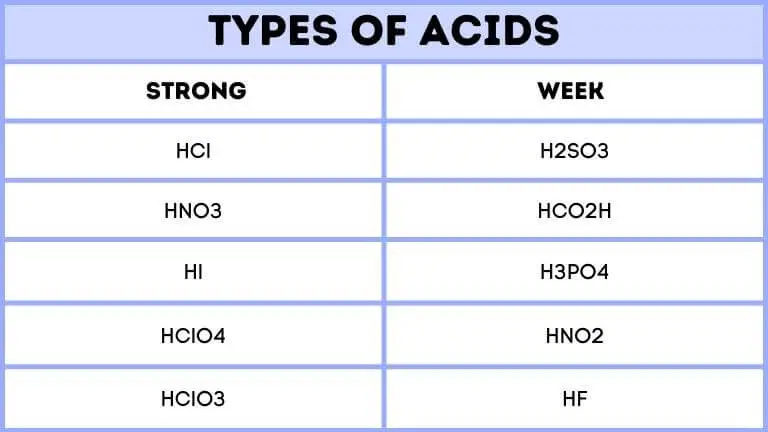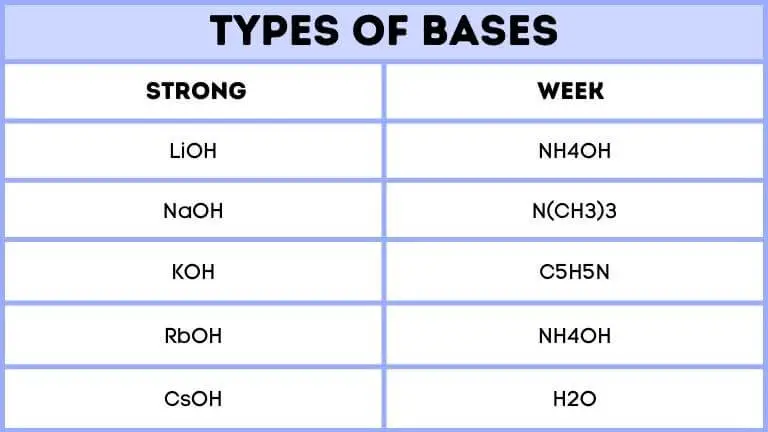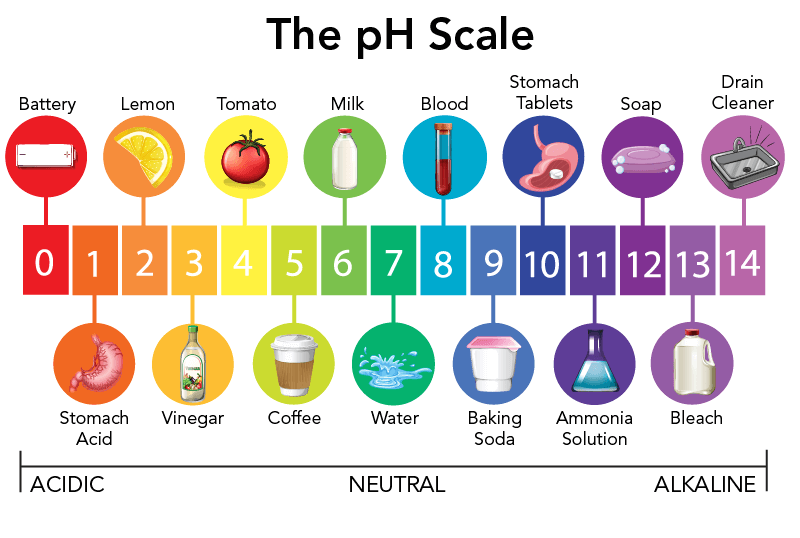Acids and bases are chemical substances which have many differences.
The main difference between acids and bases is that acids have a sour taste and mix with some metals to make salts. At the same time, bases have a bitter taste and mix with acids to form water and salts.
Acids and bases are both chemical solutions with different chemical properties. All liquids are either acids or bases. A liquid is an acid or base, depending on the types of ions present in it.
Chemical substances called bases and acids interact with one another to change both properties.
If an acid has a hydrogen ion, it is called an acid, but if it has a hydroxide ion, it is a base.
Table of Contents
What is Acid?

An acid is a substance that donates a proton to other substances.
In addition, an acid accepts electrons from others to complete its valence shell. Acids are chemicals that break down into H+ (Hydrogen) ions when dissolved in water.
Acids are a sort of chemical that can be found in many facets of our daily life, from the sour bite of a piece of fruit to the acidic solutions used to clear a blocked sink.
Amino acids, for example, have two distinct identities. They are known to be amphoteric, which indicates they may function as both acids and bases.
Acids can burn and destroy anything they come into contact with.
Properties of acids
- Acids can generate electricity, which is why they are known as electrolytes.
- The PH value of acid is lower than 7.
- Acids have a sour taste.
- Acid can be in liquid, gas and solid state.
- Acids result in H+ ions when reacting with metals such as zinc and iron.
- Acid has the property of changing blue litmus paper to red.
Types of acid
- Strong acid
- Weak acid

1. Strong acid
In order to create H+ ions, strong acids will totally dissociate. The PH value of strong acid ranges from 0 to 1. All inorganic acids are considered as strong acids.
Examples of strong acids are hydrochloric acid (HCL), sulfuric acid (H2SO4) and nitric (HNO3).
2. Weak acid
Weak acid partially breaks down to produce H+ ions. The PH value of weak acids ranges from 5 to 7. Organic acids are known as weak acids.
Examples of weak acids are acetic acid (CH3COOH) and benzoic acid (C6H5COOH).
What is a Base?

A base is a chemical that releases hydroxide (OH+) ions in water, denotes electrons, and accepts protons or both.
Bases have a slippery touch and a bitter taste. Bases are also used in the production of soaps and toothpaste.
Although bases differ from acids, they can still be strong or weak. A strong base might be just as risky and poisonous as a strong acid.
Bases are usually used in the baking industry, specifically in baking soda and cleaning products.
Properties of bases
- The base is an electron donor and proton acceptor.
- The PH value of a base varies from 7 to 14.
- In contrast, on acids, bases turn the red litmus paper into the blue.
- The taste of the base is usually bitter.
- The base can also conduct electricity like acids.
Types of bases
- Strong base
- Weak base

1. Strong base:
Strong bases decompose in water and release large quantities of OH- or hydroxyl ions.
Examples of strong bases are sodium hydroxide (NaOH) and potassium hydroxide (KOH).
2. Weak base:
Weak bases are bases that decompose into water, and it releases very few quantities of OH- ions.
Zinc hydroxide (Zn (OH)2) is an example of a weak base.
Learn more: What is the Difference Between Autotrophs and Heterotrophs?
Differentiating the Main Differences Between Acids and Bases:
Acids are molecules that contain hydrogen and have a sour taste. Bases are molecules that contain hydroxide ions and have a bitter taste.
The differentiation of acids and bases can be identified using a PH scale.
When the PH scale ranges from 0 to 7, it can be detected as acids. On the other hand, when the PH scale’s value goes from 7 to 14 is considered as base.
Acids and bases are two types of chemical substances frequently used in laboratories and industry, as well as in daily life.
They can cause reactions with each other by neutralizing each other or dissolving the other in a process called neutralization.
A liquid will be considered neutral if it has a PH value of exact 7.
There are lots of strong acids and bases in nature. A few of them are boric acids used in insecticides.
A significant component of too many soft drinks is phosphoric acid.
Many plants have acids and bases in their leaves and seeds. Such as lemon, grapes and oranges, these citrus fruits have citric acids, which have a sour taste.
Our stomach uses hydrochloric acid (HCL), which helps digest food and kill bacteria to keep us healthy.
Many household items contain bases, such as washing powder.
When acids and bases combine in a reaction, they completely neutralize each other.
Comparison Chart: Acids vs Bases
Highlighting the comparison between bases and acid in the following table:
| Acids | Bases | |
| Definition | Acids are chemicals that release hydrogen ions in water. | Bases are oxides or hydroxides when dissolved in water. |
| Taste | Acids are sour in taste. | Bases are bitter in taste. |
| Ions | Acids produce H+ ions in water. | Bases produce OH ions in water. |
| PH value | Acids have a PH value below 7. | Bases have a PH value above 7. |
| Litmus Paper | Acids turn blue litmus paper into red. | Bases turn red litmus paper into blue. |
| Examples | Sulfuric acid (H2SO4). | Sodium hydroxide (NaOH). |
Conclusion
We come to the conclusion that both acids and bases are crucial components of our lives, with the main distinction between the two being the formation of water ions and hydrogen ions when an acid combines with a base. A base, on the other hand, is a material that interacts with acids to form the hydroxide ion and water.
Acids have high acidic power, whereas bases have high basic strength.
Difference Between Acids and Bases – The pH Scale

Read more: What is the Difference Between Licensing and Franchising?


